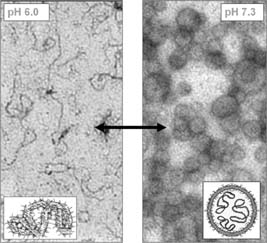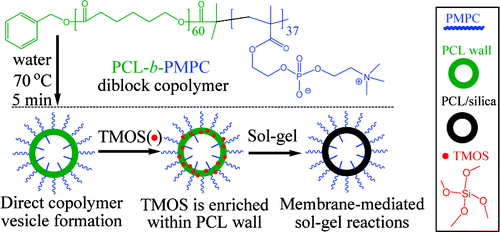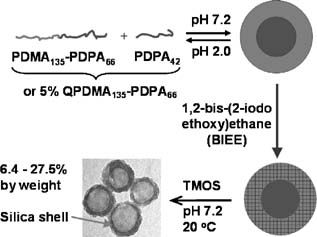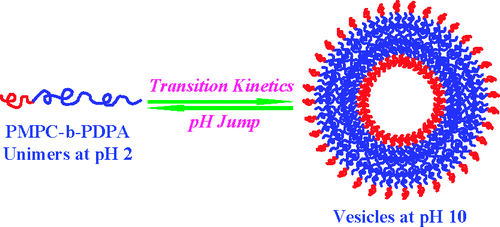- 学术论文
-
Efficient Encapsulation of Plasmid DNA in pH Se...
AbstractWe report the self-assembly of a series of amphiphilic diblock copolymers comprising a biocompatible, hydrophilic block, poly(2-methacryloyloxyethyl phosphorylcholine) (PMPC) and a pH-sensitive block, poly(2-(diisopropylamino)ethyl methacrylate) (PDPA), into a dispersion of colloidally stable, nanometer-sized polymersomes at physiological pH and salt concentration. The pH-sensit...[详细]
 2010-05-14
2010-05-14 -
Advances and challenges in smart and functional...
AbstractPolymer vesicles prepared by self-assembly techniques have attracted increasing scientific interest in recent years. This is as a result of their numerous potential applications such as tunable delivery vehicles, for the templating of biomineralization, as nanoreactors and as scaffolds for biological conjugation. Presented in this review are the recent advances in the prepar...[详细]
 2009-07-28
2009-07-28 -
Preparation of Biocompatible Zwitterionic Block...
AbstractThe facile preparation of block copolymer vesicles in pure water and their subsequent stabilization by sol−gel chemistry within the vesicle membrane is described. An amphiphilic biocompatible zwitterionic diblock copolymer, poly(ε-caprolactone)-block-poly[2-(methacryloyloxy)ethyl phosphorylcholine], PCL-b-PMPC, was synthesized by (i) ring-opening polymerization of ε-caprolact...[详细]
 2009-07-02
2009-07-02 -
Shell Cross-Linked Micelles as Cationic Templat...
AbstractThe mean diameter of poly[2-(dimethylamino)ethyl methacrylate]-block-poly[2-(diisopropylamino)ethyl methacrylate] (PDMA-PDPA) diblock copolymer micelles can be easily adjusted from 27–155 nm (as measured by DLS) by either selective quaternisation of the PDMA block or by adding PDPA homopolymer prior to micellisation; these self-assembled nanostructures can be shell crosslinke...[详细]
 2009-01-20
2009-01-20 -
Preparation of Primary Amine-Based Block Copoly...
AbstractA new amphiphilic biocompatible diblock copolymer, poly(ε-caprolactone)-block-poly(2-aminoethyl methacrylate), PCL-b-PAMA, was synthesized in three steps by (i) ring-opening polymerization of ε-caprolactone, (ii) end-group modification by esterification, and (iii) atom transfer radical polymerization (ATRP) of 2-aminoethyl methacrylate hydrochloride (AMA) in its hydrochloride ...[详细]
 2008-10-27
2008-10-27 -
Kinetics of pH-induced formation and dissociati...
AbstractThe kinetics of pH-induced formation and dissociation of vesicles self-assembled from a biocompatible zwitterionic diblock copolymer, poly(2-(methacryloyloxy)ethyl phosphorylcholine)-b-poly(2-(diisopropylamino)ethyl methacrylate) (PMPC-b-PDPA), was investigated in detail via a combination of stopped-flow light scattering and laser light scattering (LLS). Upon jumping from pH 2 t...[详细]
 2008-08-06
2008-08-06 -
Toward a new lower limit for the minimum scatte...
AbstractThe main characteristics of the very small angle neutron scattering spectrometer (VSANS) under construction at the Laboratoire Léon Brillouin are a multibeam pinhole collimator converging onto an image plate detector. By combining tiny collimation (diaphragms of around 1 or 2 mm in diameter) with the small pixel size of the detector (0.15 × 0.15 mm), very high resolution measurement...[详细]
 2008-04-01
2008-04-01 -
Non-cytotoxic polymer vesicles for rapid and ef...
AbstractWe have recently achieved efficient cytosolic delivery by using pH-sensitive poly(2-(methacryloyloxy)ethylphosphorylcholine)-co-poly(2-(diisopropylamino)ethylmethacrylate) (PMPC–PDPA) diblock copolymers that self-assemble to form vesicles, known as polymersomes, in aqueous solution. It is particularly noteworthy that these diblock copolymers form stable polymersomes at physiologica...[详细]
 2007-11-12
2007-11-12 -
Biomimetic pH-Sensitive Polymersomes for Effici...
AbstractA novel gene delivery vector based on the ability of a synthetic amphiphilic block copolymer to mimic biological phospholipids by forming membrane-enclosed structures, specifically nanometer-sized vesicles, is presented. A pH-sensitive diblock copolymer forms vesicles (polymersomes) at neutral pH, and dissolves completely as unimers at endocytic pH (see figure). GFP-enco...[详细]
 2007-11-12
2007-11-12 -
Perforated Block Copolymer Vesicles with a High...
Closure of block copolymer bilayer in the solution generates the so-called polymeric vesicles or polymersomes with the solvent fills in their internal spaces. Recently, polymeric vesicles have attracted a great attention not only from academia but also from application field for drug delivery.1 Simple block copolymer vesicles, spherical topology with one compartment, have been well recognized...[详细]
 2007-06-01
2007-06-01 -
Gelation Inside Block Copolymer Aggregates and ...
AbstractLike in many other cases, block copolymers bearing alkoxysilyl groups in one segment self-assemble into aggregates. However, they may allow one to study the sol-gel reaction by making use of the gelable groups located in the domains of the aggregates, therefore, the gelation process can be made in a selected domain of the nanoscale. As a result, the organic nanostructure is tran...[详细]
 2006-04-28
2006-04-28 -
New folate-functionalized biocompatible block c...
AbstractThe main objective of this study was to synthesize novel folic acid-functionalized diblock copolymer micelles and evaluate their solubilization of two poorly water-soluble anti-tumor drugs, tamoxifen and paclitaxel, which suffer from low water solubility and/or poor hydrolytic stability. The diblock copolymer consisted of a permanently hydrophilic block comprising 2-(methacryloyloxy)eth...[详细]
 2006-04-19
2006-04-19









